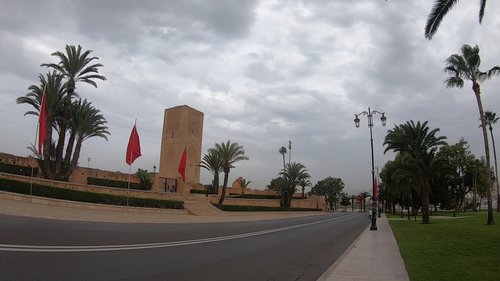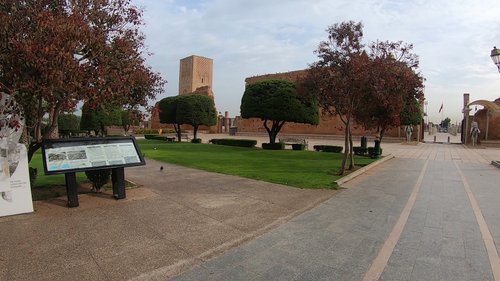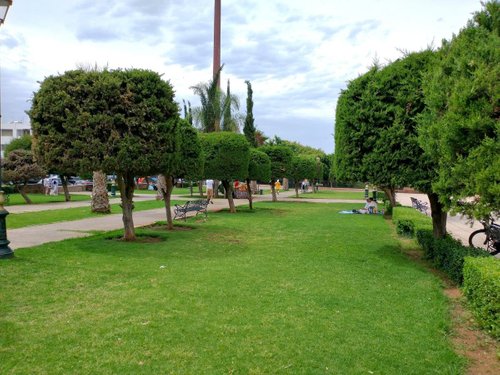Hassan Tower, Rabat-Sale-Kenitra, Morocco
4.0 (1.353 reviews) Spent 1-2 hours Ranking #6 in Rabat Architectural Buildings • Religious Sites

Worth a visit
The unfinished minaret surrounded by two hundred columns is Rabat's most famous monument.



Address
Boulevard Mohamed Lyazidi, Rabat 10030 Morocco
Current local date and time now
Tuesday, April 30, 2024, 7:08
User Ratings
4.0 based on (1.353 reviews)
Excellent
36%
Good
45%
Satisfactory
16%
Poor
2%
Terrible
1%
Reviews
-
4Frank D 5:00 PM Jun 9, 2022
Ruins thaat aren't ruined and a beautiful mausoleum
By the main entrance a beautiful park frequented by locals relaxing runs along the wall. At all entrances are the royal guards on white horses! Construction of the Hassan Tower started in the 12th century. It was intended to become the minaret for the largest mosque in the entire world but the Moroccan ruler Yacoub al-Mansour who had begun the project died before it could be completed. Near the front of the unfinished minaret lies the beautiful Mausoleum of King Mohammad V and his two sons.







-
4retireeVancouver 5:00 PM Dec 28, 2022
Tower was a world wonder in the 12th century; today, only a photo stop
The first thing we saw before entering the square were the 2 red uniformed military sentries on horseback, one on each side of the gate. The gate is attached to a rusty red ancient wall which once surrounded the square. Parts of the wall are still standing and at varying heights. Birds nest in the holes in this wall, but I am sure that’s not their purpose. As I entered the square , it was awe inspiring to see what looked like a field of columns, ranging in height from 12 feet (some probably higher) to 5 feet, evenly spaced in neat rows (21 rows in fact) and filling this spacious square. The columns vary in height because some of the columns crumbled during the 1755 earthquake and it doesn’t seem likely that those will be restored. These columns look sturdy and are made from stacked rounds of stone; they are not spindly columns often seen in arcaded Moorish buildings. These columns had been most likely erected to hold up the intended mosque’s interior arches. The tall rusty red Hassan Tower is situated at one end of this square behind those columns. The tower is rectangular in shape with Moorish carvings on the top half of all 4 sides. One can see slits on the sides of the tower which were used to light up the interior. The doorway to the tower was blocked from entry, but Imams once used its interior ramps to walk up to the top of the tower to read prayers. Even today the tower still seems tall as it looms over the shorter columns in front of it. The focus in this square is certainly the Hassan Tower and the sea of ruined columns. The Mohammad V Mausoleum and Museum, built along one side of this square, were a secondary focus for me. Both were closed in October 2022. When they open, this square will be even more of a draw for tourists to visit. This tower was once the tallest structure in the world when it was built in the 12th century. Today it is only a photo stop for tourists.
See also
More Things to do in Rabat
- Points of Interest & Landmarks in Rabat
- Architectural Buildings in Rabat
- Churches & Cathedrals in Rabat
- Historic Sites in Rabat
- Art Museums in Rabat
- Speciality Museums in Rabat
- Religious Sites in Rabat
- Gardens in Rabat
- Trams in Rabat
- Marinas in Rabat
- Hammams & Turkish Baths in Rabat
- Spas in Rabat
- Speciality & Gift Shops in Rabat
- Taxis & Shuttles in Rabat
- Health Clubs in Rabat
- Equestrian Trails in Rabat
- Beaches in Rabat
- Game & Entertainment Centers in Rabat
- Farms in Rabat
- Shopping Malls in Rabat
- Water Parks in Rabat
- Amusement & Theme Parks in Rabat
- Eco Tours in Rabat
- Golf Courses in Rabat
- Cemeteries in Rabat
- Paint & Pottery Studios in Rabat
- Rail Services in Rabat
- Music Festivals in Rabat
- Coffeehouses in Rabat